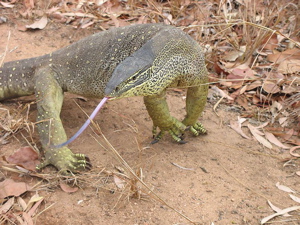On the Origins of New Forms of Life
4.2: Alternative Life Cycles
(Continued from the previous page)

|
| Yellow-spotted Goanna |
Many organisms with a sexual life cycle can also reproduce vegetatively. For example, many seed plants can propagate from a detached twig or leaf. Hybrids treated as various species of the European blackberry genus Rubus are seed-sterile, but can reproduce both agamospermously and vegetatively.
The Yellow-spotted Goanna (Varanus panoptes), shown at right, is a varanid lizard that usually reproduces by means of sex. But Lenk et al. (2005) report that V. panoptes females are also capable of parthenogenetic reproduction. Many organisms can reproduce by alternative means.
For example, many members of the genus Rubus, just mentioned, not only can produce seed both sexually and agamospermously, but also can produce offspring vegetatively by rooting of stem tips.
Different types of organisms reproduce by these modes at different rates. How often any given type of life cycle is employed depends on the organism in question. For example, Yellow-spotted Goannas rarely reproduce parthenogenetically. Their normal life cycle is sexual. An agamosperm reproduces primarily by agamospermous means. But most agamosperms are also capable of sexual reproduction, at least at low levels. As Grant (1981: 11) points out,
Some organisms (e.g., many parasitic worms, aphids, gall wasps) actually alternate parthenogenesis and sexual reproduction seasonally, or in response to various environmental factors. Earthworms are hermaphrodites and reproduce sexually in pairs, but can also regenerate an entire body from a severed piece. Potentially, hermaphroditic organisms can self, but many types either regularly mate, or can alternatively mate, with other individuals (they can outcross). Relative rates of self-fertilization and outcrossing vary widely from one type of organism to another. Some types of hermaphrodites virtually always outcross, while others nearly always self. Earthworms, just mentioned, are an example of the former. An example of the latter is suckling clover (Trifolium dubium).
Haberer's Groundpine, Lycopodium habereri, a plant of hybrid origin (from the cross L. digitatum × L. tristachyum), can reproduce both through spores and vegetatively. The ability to reproduce by alternative means can allow hybrids of very low fertility to produce later-generation hybrids even by the sexual route. For example, Stebbins (1959: 236–237) describes work he carried out on hybrids between Leymus triticoides (beardless wildrye) and L. condensatus (giant wildrye). These two very distinct types of grasses hybridize easily. The F1 hybrids are vigorous and intermediate in appearance, but extremely infertile. Stebbins (1959: 236) states that
Stebbins goes on to say that this array of intermediate types was no doubt produced by rare sexual propagation on the part of the F1 hybrid, which usually engages only in vegetative reproduction. He points out that each year a single such hybrid clone can produce 1000 flowering stems, each with about 200 florets, a total of 200,000 florets. Stebbins calculates that even if the hybrid's fertility were extremely low (one fertile seed per 100,000 florets), it would still produce two seeds annually, which would amount to 200 seeds over a 100-year lifetime. So a single such hybrid plant could produce 200 later-generation hybrids. These would maintain themselves by vegetative reproduction or, in the case of those showing a higher grade of fertility, by sexual reproduction as well. His own investigations led Stebbins to believe such situations, where highly sterile hybrids occasionally produce offspring by sexual means, are not uncommon among grasses and a wide variety of other plants (Stebbins 1959: 236).
The various epithets used to pigeonhole organisms, such as parthenogen, apomict, sexual, outcrosser, selfer, agamosperm, etc., — are generalizations. Relatively few organisms reproduce by one and only one of these modes. An organism may be called a "parthenogen," but still at times reproduce sexually. The name parthenogen usually means only that parthenogenesis is an organism's usual, not its exclusive, mode of reproduction. A predominantly sexual plant may be called "sexual," but still at times reproduce apomictically. A plant that usually self-fertilizes may be called a "selfer" and still outcross on occasion. In order to understand various statements in the upcoming discussion, it will be important to keep these facts in mind. For example, it might seem contradictory to speak of "agamosperms hybridizing" if one did not realize many organisms that reproduce primarily by agamospermous means are also capable of occasional sexual reproduction. NEXT PAGE >>
Most shared on Macroevolution.net:
Human Origins: Are we hybrids?
On the Origins of New Forms of Life
Mammalian Hybrids
Cat-rabbit Hybrids: Fact or fiction?
Famous Biologists
Dog-cow Hybrids
Georges Cuvier: A Biography
Prothero: A Rebuttal
Branches of Biology
Dog-fox Hybrids